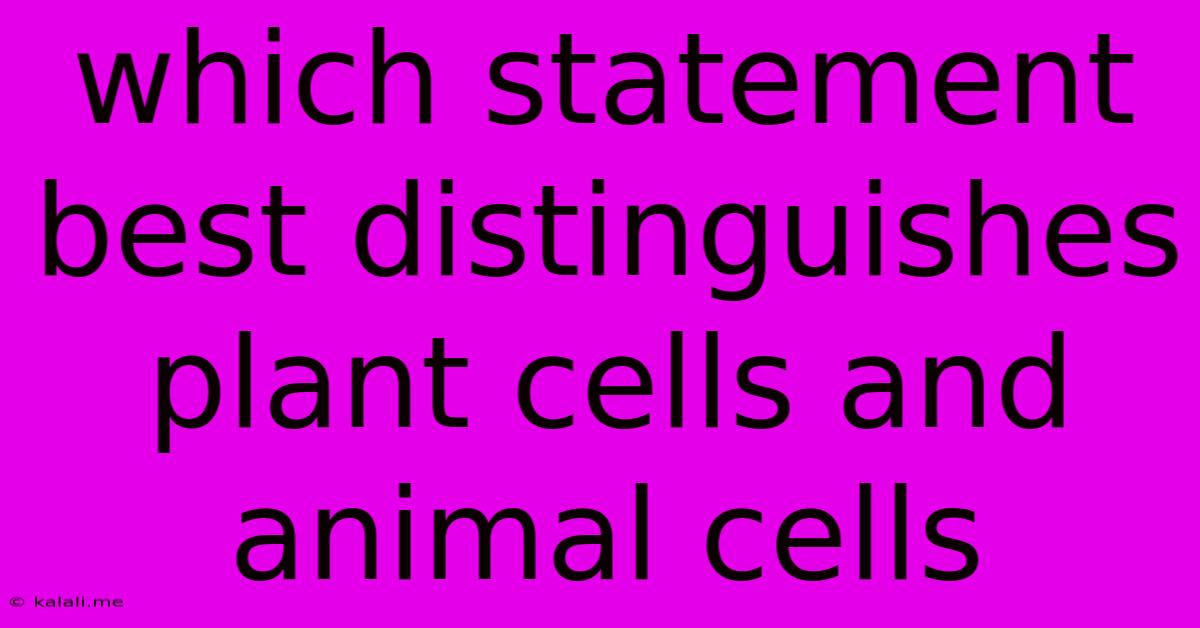Which Statement Best Distinguishes Plant Cells And Animal Cells
Kalali
Jun 15, 2025 · 2 min read

Table of Contents
The Defining Difference: What Truly Sets Apart Plant and Animal Cells?
Understanding the fundamental differences between plant and animal cells is crucial in biology. While both are eukaryotic cells sharing many similarities, one key feature decisively distinguishes them. This article will explore the characteristics of both cell types and pinpoint the statement that best highlights their unique identities. We'll also delve into other important distinctions to provide a comprehensive understanding of these vital building blocks of life.
Beyond the Nucleus: Key Similarities and Differences
Both plant and animal cells possess a nucleus, containing the cell's genetic material (DNA), and various other organelles like mitochondria (the powerhouses of the cell), ribosomes (protein synthesis factories), and the endoplasmic reticulum (involved in protein and lipid synthesis). However, several structural and functional differences set them apart. These include the presence or absence of a cell wall, chloroplasts, and vacuoles.
The Defining Feature: The Cell Wall
While many differences exist, the statement that best distinguishes plant cells from animal cells is the presence of a rigid cell wall in plant cells. This cell wall, primarily composed of cellulose, provides structural support and protection, maintaining the cell's shape and preventing osmotic lysis (bursting due to excess water uptake). Animal cells, lacking this protective outer layer, rely on their flexible cell membrane for structural integrity.
Other Notable Differences: Chloroplasts and Vacuoles
Further reinforcing the distinction, plant cells contain chloroplasts, the sites of photosynthesis where sunlight is converted into chemical energy. This ability to produce their own food is a defining characteristic of plants and algae, setting them apart from animal cells, which are heterotrophic (they obtain energy from consuming other organisms).
Moreover, plant cells typically possess a large central vacuole, a fluid-filled sac that maintains turgor pressure (the pressure exerted by the cell contents against the cell wall), stores water and nutrients, and plays a role in waste disposal. While animal cells may have smaller vacuoles, they lack the prominent central vacuole characteristic of plant cells.
Summary of Key Distinctions
Let's summarize the key differences in a table for clarity:
| Feature | Plant Cell | Animal Cell |
|---|---|---|
| Cell Wall | Present (Cellulose) | Absent |
| Chloroplasts | Present | Absent |
| Central Vacuole | Large, central vacuole | Small or absent |
| Shape | Rigid, defined shape | Flexible, varied shapes |
Conclusion: The Cell Wall Reigns Supreme
In conclusion, while numerous differences exist between plant and animal cells, the presence of a rigid cell wall made of cellulose most accurately and concisely distinguishes plant cells from animal cells. Understanding these fundamental differences is essential for comprehending the unique characteristics and functionalities of plant and animal life. The other differences, such as chloroplasts and large central vacuoles, further support this primary distinction.
Latest Posts
Latest Posts
-
What Type Of Membrane Is The Skin
Jun 16, 2025
-
Select The Correct Statement About Synapses
Jun 16, 2025
-
How Many Players On Hockey Team
Jun 16, 2025
-
What Is The Gap Between Two Neurons Called
Jun 16, 2025
-
The Law Of Demand Implies That
Jun 16, 2025
Related Post
Thank you for visiting our website which covers about Which Statement Best Distinguishes Plant Cells And Animal Cells . We hope the information provided has been useful to you. Feel free to contact us if you have any questions or need further assistance. See you next time and don't miss to bookmark.